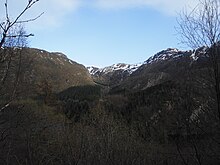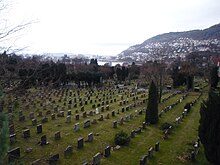Isdal woman
The Isdal woman ( Norwegian : Isdalskvinnen ) was found dead on November 29, 1970 in the Isdal Valley near Bergen, Norway . Both the identity of the woman and the circumstances surrounding her death are still unclear. The Norwegian police reopened the case in 2016 with the support of the television broadcaster NRK, as modern analysis methods made it possible to evaluate the DNA more precisely .
discovery
On the afternoon of November 29, 1970, a university professor and his two daughters, who were hiking in the Isdal Valley near Mount Ulriken , saw a half-burned woman's body on a slope. She was 1.64 meters tall and had brown hair which was tied in a ponytail. Beside her lay the remains of clothing and jewelry, a pair of rubber boots , a liquor bottle, two plastic bottles that smelled of gasoline, a jar with sleeping pills , a silver spoon and a burnt passport cover. The body lay on its back with arms held in front of it, which is typical for burn victims. It was noticeable, however, that only the front of the body was burned, but not the back. Another peculiarity was the carefully removed labels on the bottles, clothing and other items, which made traceability impossible.
Investigations
Inquiries to all police stations in the country brought no results, and there were no corresponding missing person reports . However, a few days later, two suitcases were found at the luggage storage facility at Bergen train station , which had already been handed in there on November 23. Fingerprints were found on it , which could clearly be assigned to the dead person. The suitcases contained other items of clothing, cosmetics and wigs, as well as 500 German marks , 130 Norwegian kroner , Swiss and British coins and a shopping bag from a shoe shop in Stavanger , to which the blue rubber boots found at the crime scene could be assigned. The owner of the shop remembered a woman who had bought the boots a few days earlier and who spoke English with an accent .
There was also a writing pad in the suitcase, the first page of which was written with codes. These were deciphered by the investigators as designations for the former whereabouts of the woman. All identification marks had been carefully removed from all objects, as well as at the crime scene.
Apparently the woman had traveled all over Europe using at least nine pseudonyms and several forged passports. Eyewitnesses described her as elegantly dressed and around 25 to 40 years old. Due to the consequent removal of traces, theories about a possible espionage activity of women developed. On some registration forms in hotels she pretended to be an antique dealer in German . She is also said to have spoken English , French and Dutch .
The autopsy revealed that the cause of death was a combination of burns and medication. Fifty incompletely dissolved sleeping pills were found in the woman's stomach. Thus, suicide was assumed to be the official cause of death . However, a bruise was discovered on the back, which could be the result of a fall or a blow with a blunt object. On February 5, 1971, the Isdal woman was buried according to the Catholic rite .
Thanks to modern dental analyzes, it became possible to determine the eating behavior and thus the possible origin of the woman. This was probably in Eastern Europe , but apparently the woman moved to Western Europe as a child or adolescent around the time of World War II .
Further examinations of the teeth were carried out in Sweden. An analysis of the tooth enamel showed a low concentration of C14, which suggests that the teeth were formed before atom bomb tests increased the C14 concentration in the atmosphere significantly. Examination of the dentin revealed that the woman was between 36 and 44 years old at the time of her death. The woman had previously been estimated to be significantly younger.
In 2005, a then 26-year-old resident of Bergen reported that he had hiked from Arna to Bergenhus five days before the body was found and that near the Brushytten he had seen a woman accompanied by two men of southern appearance in black coats. The woman's clothing was not suitable for hiking and she looked scared herself. She would have opened her mouth to say something, but would have hesitated, probably for fear of the reaction of her companions. After the case was made public, the resident contacted an acquaintance who worked for the police because he recognized the woman in the pictures. The acquaintance advised him to forget the matter, the case would never be solved.
See also
Web links
- Ståle Hansen: The Isdalen Enigma. Norwegian Broadcasting , November 29, 2016 (with embedded video in Norwegian with English subtitles).
- Stephen Missal, Ståle Hansen, Øyvind Bye Skille, Marit Higraff, Eirin Aardal, Ellen Borge Kristoffersen: Do you remember this woman? Norwegian Broadcasting Company's wanted advertisement , November 29, 2016 (Norwegian).
- Helier Cheung: Isdal Woman: The mystery death haunting Norway for 46 years. British Broadcasting Corporation , May 13, 2017 (English).
- Interpol Isdalwoman Black Notice. (pdf, 45 kB) Interpol , May 10, 2017(English).
- Marit Higraff and Neil McCarthy: Death in Ice Valley (Podcast with 10 episodes). In: British Broadcasting Corporation . 2018 (English).
- Tanja Stelzer: Norway: The dead from the Isdal. In: The time . January 10, 2018 .
- Kirsten Tromnau, Claudia Kaffanke: The Isdal woman - a criminal search for clues. In: SWR2 broadcast “Knowledge”. July 5, 2018 (as a pdf manuscript (162 kB) and as an mp3 audio file (27:26 minutes; 24 MB)).
- Wiebke Tomescheit: The most puzzling criminal case in Norway: Was the unknown dead woman a German spy? In: stern.de . 7th July 2018 .
- Sabine Rückert and Andreas Sentker: Die Tote im Eistal (Podcast: Verbrechen). In: zeit.de . March 26, 2019 .
Individual evidence
- ↑ Monika Nordland Yndestad: Her Baeres Isdalskvinnen til sitt anonymous gravsted. In: Bergensavisen. March 20, 2005, accessed May 30, 2017 (Norwegian).
- ↑ Diego Perini: 'Major breakthrough' in Norway's 46-year-old Isdal woman mystery. In: British Broadcasting Corporation . May 19, 2017, accessed May 30, 2017 .
- ↑ Øyvind Bye Skille, Marit Higraff, Ståle Hansen: Tennene avslører: Isdalskvinnen eldre enn man trodde. In: Norwegian Broadcasting . January 8, 2018, accessed January 11, 2018 (Bokmål in Norwegian).
- ↑ Monika Nordland Yndestad: Turgåer Motte Isdalskvinnen. Bergensavisen, March 20, 2005, accessed January 14, 2019 (Norwegian).
| personal data | |
|---|---|
| SURNAME | Isdal woman |
| ALTERNATIVE NAMES | Isdalskvinnen |
| BRIEF DESCRIPTION | unknown female fatality in Norway |
| DATE OF BIRTH | between 1925 and 1934 |
| DATE OF DEATH | 1970 |

